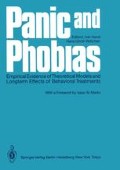Abstract
Panic attacks are defined as sudden onset episodes of intense anxiety accompanied by a range of unpleasant bodily sensations (American Psychiatric Association 1980). Patients report that cognitions accompanying such attacks commonly concern ideas of going mad, having a heart attack or other acute medical emergency, or of losing control of their behaviour in such a way as to disgrace themselves (Beck, Laude and Bohnert 1974; Hibbert 1984). Panic attacks occur in both phobic and non-phobic anxiety states. In the former case, it has been argued that the fear of such panic attacks may be responsible for the avoidance behaviour which plays such a prominent part in agoraphobia (Goldstein and Chambless 1978).
Access this chapter
Tax calculation will be finalised at checkout
Purchases are for personal use only
Preview
Unable to display preview. Download preview PDF.
References
American Psychiatric Association (1980) Diagnostic and Statistical Manual of Mental Disorders, Third Edition. American Psychiatric Association, Washington
Balke B, Ellis JP, Wells JG (1958) Adaptive responses to hyperventilation. J Appl Physiol 12:269–277
Bass C, Cawley R, Wade C, Ryan KC, Gardener WN, Hutchinson DCS, Jackson G (1983) Unexplained breathlessness and psychiatric morbidity in patients with normal and abnormal coronary arteries. The Lancet, i, 605–609
Beck AT, Beamsderfer A (1974) Assessment of depression: the depression inventory. In: Pichot P (ed) Modern problems in pharmacopsychiatry. (Vol 7) Karger, Basel
Beck AT, Emery G, Greenberg RL (1985) Anxiety disorders and phobias: A cognitive perspective. Basic Books, New York
Beck AT, Laude R, Bohnert M (1974) Ideational components of anxiety neurosis. Arch Gen Psychiatry 3:319–325
Cambell EJM, Howell JBL (1962) Measurement of mixed venous pCO2. Brit Med J ii: 630–633
Clark DM (1979) Therapeutic aspects of increasing pCO2 by behavioural means. Unpublished M. Phil, thesis, University of London
Clark DM (1986) A cognitive approach to panic. Beh Res Ther, in press
Clark DM, Hemsley DR (1982) Effects of hyperventilation: individual variability and its relation to personality. J Beh Ther Exp Psychiatry 13:41–47
Clark DM, Salkovskis PM, Chalkley AJ (1985) Respiratory control as a treatment for panic attacks. J Beh Ther Exp Psychiatry 16:23–30
Gibson HB (1978) A form of behaviour therapy for some states diagnosed as “affective disorder”. Beh Res Ther 16:191–195
Goldstein AJ, Chambless DL (1978) A re-analysis of agoraphobia. Behav Ther 9:47–59
Hibbert GA (1984) Ideational components of anxiety: their origin and content. Br J Psychiatry 144:618–624
Huey SR, West SG (1983) Hyperventilation: Its relation to symptom experience and anxiety. J Abnorm Psychol 92:422–432
Kerr WJ, Dalton JW, Gliebe PA (1937) Some physical phenomena associated with anxiety states and their relation to hyperventilation. Ann Intern Med 11:961–992
Keselman HJ, Rogan JC (1980) Repeated measures F tests and psychophysiological research: Controlling the number of false positives. Psychophysiology 17:499–503
Lang PJ (1970) Stimulus control, response control and the desensitization of fear. In: Levis DJ (ed) Learning approaches to therapeutic behavior. Aldine Press, Chicago
Lum LC (1976) The syndrome of habitual chronic hyperventilation. Hill OW (ed) Modern trends in psychosomatic medicine. 3, Butterworths, London
Marks IM, Mathews A (1979) Brief standard self-rating for phobic patients. Beh Res Ther 17:263–267
Salkovskis PM, Jones DRO, Clark DM (1986) Respiratory Control in the treatment of panic attacks: replication and extension with concurrent measures of behaviour and pCO2. Br J Psychiatry, in press
Salkovskis PM, Clark DM, Jones DRO (1986) A Psychosomatic mechanism in anxiety attacks; the role of hyperventilation in social anxiety and cardiac neurosis. In: Lacey H, Sturgeon J (eds) Proceedings of the 15th European Conference on Psychosomatic Research, London 1984
Salkovskis PM, Warwick HMC, Clark DM, Wessels DJ (1986) A demonstration of acute hyperventilation during naturally occurring panic attacks. Beh Res Ther 24:91–94
Schachter S, Singer JE (1962) Cognitive, social and physiological determinants of emotional state. Psychol Rev 69:379–399
Seuss WM, Alexander AB, Smith DD, Sweeney HW, Marion RJ (1980) The effects of psychological stress on respiration: a preliminary study of anxiety and hyperventilation. Psychophysiology 17:535–540
Stampler FM (1982) Panic disorder: description, conceptualisation, and implications for treatment. Clin Psychol Review 2:469–486
Svebak S, Grossman P (1985) How aversive is hyperventilation? Clinical Respiratory Physiology, 21, in press
van den Hout MA, Griez E (1984) Carbondi-oxide and anxiety: an experimental approach to a clinical claim. Thesis, Rijksuniversiteit Maastricht
Editor information
Editors and Affiliations
Rights and permissions
Copyright information
© 1986 Springer-Verlag Berlin Heidelberg
About this paper
Cite this paper
Salkovskis, P.M., Clark, D.M. (1986). Cognitive and Physiological Processes in the Maintainance and Treatment of Panic Attacks. In: Hand, I., Wittchen, HU. (eds) Panic and Phobias. Springer, Berlin, Heidelberg. https://doi.org/10.1007/978-3-642-71165-7_10
Download citation
DOI: https://doi.org/10.1007/978-3-642-71165-7_10
Publisher Name: Springer, Berlin, Heidelberg
Print ISBN: 978-3-642-71167-1
Online ISBN: 978-3-642-71165-7
eBook Packages: Springer Book Archive

